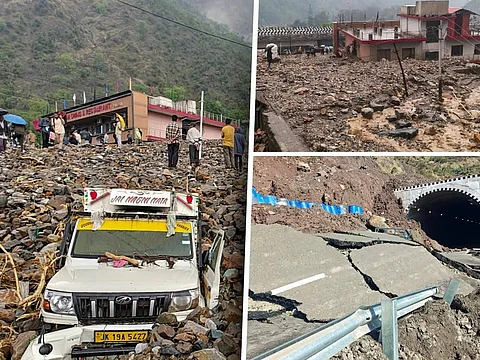
- Destinations
- Experiences
- Stay
- What's new
- Celebrating People
- Responsible Tourism
- CampaignsCampaigns
- Subscribe
- Buy Now

On April 20, 2025, a devastating cloudburst struck the Seri Bagna village in Jammu and Kashmir's Ramban district, claiming at least three lives. This incident was part of a series of recent rain-related disasters in the Jammu region, which have left five people dead in the last two days. A day prior, on April 19, two more people lost their lives and another person was injured after lightning struck the Arnas area in Reasi district. Rescue teams are currently conducting operations to locate survivors in the area.
A cloudburst previously struck Himachal Pradesh during the monsoon season from June to August 2024, when 31 people were killed in 51 separate incidents. Intense rainfall in the Himalayan regions of Kashmir and the adjacent mountainous cold desert of Ladakh in 2023 similarly destroyed roads and caused flooding in dozens of villages.
However, perhaps the most notable cloudburst event in India occurred in Uttarakhand in 2013, becoming the country's worst natural disaster since the 2004 tsunami. According to figures provided by the state government, the death toll was a staggering 6,054 people, and over 70,000 pilgrims on the Char Dham Yatra were stuck because of damaged or blocked roads. This disaster was the setting for the 2018 Hindi film “Kedarnath,” a doomed love story set among the historic temple that was affected by the cloudburst.
But, what is a cloudburst, how does it occur and what can you do to stay safe? Read our explainer to find out.
A cloudburst is a sudden occurrence of very heavy rainfall that is usually local in nature and of a brief duration. Technically speaking, an event can be deemed to be a cloudburst if rainfall of 10 cm or more falls in an hour over a roughly 10 km x 10 km area.
Cloudbursts are more common in hilly areas because of a phenomenon called orographic lift, which refers to warm air rising up the side of a mountain. As warm air ascends upwards on a mountain, it expands because of the low pressure above. The expanding air cools, releasing the moisture it was holding as rain. But if more and more warm air keeps rising, it prevents that rain from falling, till finally a large amount of rain builds up and bursts out in a massive shower all at once.
Nearly all recorded cloudbursts in the Indian subcontinent occur when monsoon clouds drift from the Arabian Sea to the Himalayas.
The sudden rain released by a cloudburst can quickly overwhelm drainage systems and lead to flash floods and landslides. The effects are especially striking on mountain slopes because the falling water is concentrated in valleys and gullies.
Cloudbursts cause waterlogging and flash floods in deserts and plains. They are usually accompanied by lightning, thunder, strong gusts of wind and hailstorms. In extreme circumstances, flooding associated with cloudbursts can shut down an entire city as people struggle to cope with the influx of water.
Experts say the frequency of extreme weather-related events, including cloudbursts, has been increasing in recent years, partly due to climate breakdown. They say the damage caused by cloudbursts is also increasing because of unplanned development in mountain regions. For instance, the subsidence of Joshimath in Uttarakhand received widespread coverage in 2021 due to rampant infrastructure development, including the construction of roads and luxurious hotels, in a fragile mountainous area.
Mukhtar Ahmed, an official at the India Meteorological Department’s (IMD) Kashmir office, has been reported as saying that global heating is increasing the frequency of cloudbursts. This is because global heating is leading to more water evaporation, which causes dense cumulonimbus clouds to form, resulting in intense rainfall. While some regions receive intense rainfall, the phenomenon of global heating is resulting in prolonged droughts in other regions.
Experts also recommend avoiding excessive deforestation and unplanned developments in climate-vulnerable regions such as the Himalayas, as it increases the chances of landslides.
Cloudbursts are difficult to predict by their very nature, but a Doppler radar system can help. Following the 2013 disaster in Uttarakhand, demands were made to equip monitoring stations in cloudburst-prone areas with this system. Stations with the technology are still few and far between, even in the Himalayan states, making forecasting difficult.
During a cloudburst event, the best thing to do is to listen to the advice and warnings of the IMD and other local officials, and move to higher ground to minimise the loss of life.
(With inputs from multiple news sources)
